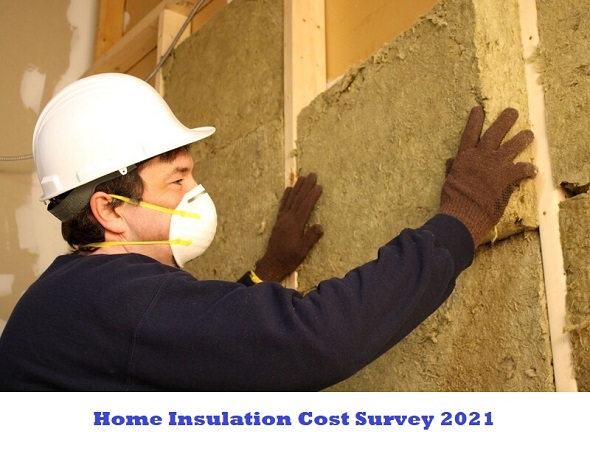
Hi folks,
recently we did a home insulation cost survey on some insulation contractors on our website. We asked what is the best way to increase the insulation in a typical semi detached house and how much would it cost including VAT to put it in place. Here is a selection of the replies we got below:-
Steven from Kildare: For interior wall insulation I using metal framing and insulated Dry lining plasterboard 50 mm or 72mm. Fixing metal sections to wall at min. 600mm centres. Short pieces of section should be placed horizontally at midpoint of boards. After will be placed the insulated plasterboard and plastered the walls and painted. In this case no contact between wall and insulation board, no chance for moulds and damp from the external wall. Walls need to be ventilated. We know the humidity in Ireland it’s high. The air flow must be present in the house and between external walls and dry walls. Cost of materials is for 1 square meter is between 38€ to 50€ Finished painted. My labour is 85€ / square meter Finished painted.
Alan from Wexford: You put in pumped bead in the walls about €15 meter and put in 75m pir between the rafters cost of that is about €21.50 a meter.
Gary from Kilkenny: The standard for insulation in a roof space at the moment is 300mm ,200mm of insulation with bring it up to code, I do not recommend pumping the cavity with insulation as the cavity is there for a reason, I only recommend doing insulated board internally, at the moment there is a grant with the seai, 400 towards attic insulation, total cost of attic insulation is €1,150 plus VAT, roof vent tiles extra, this depends on ventilation in attic, there are also grants available for internal dry lining with insulated boards,I recommend to all my customers to clean out the attic tank with Milton and running through the pipe work,you can get sick from the water in the tank if drank as small animals can get into it and if it is left stagnant legionnaires disease is a possibility.
Cillian from Wicklow: If the house permits it, the walls could be pumped, this is a type of small balls of insulation that fill the cavity and is an excellent job ( we had this job done ourselves on our own house about eight years ago and the effects were only instant). Failing that, probably the insulated plasterboard is the next method. The problem with this is that it’ll reduce the size of the room…. the thicker the board the better the results. There are other unforeseen works associated with this method as window boards will have to be replaced, additional work to sockets and plumbing to radiators not to mention skirtings, floor finishes, installation of the boards itself, plastering and of course painting. In terms of costs, I don’t actually have a set rate for any of the above methods. I simply size up each individual job , work out the materials required and estimate how long the job would take thereafter.
Thomas from Dublin: I would charge €8000 50m boards on all window walls and 30m boards on the down stairs ceiling and roll insulation into the attic and then skim skip for the rubble not sure what to say about payments i always if the job is big enough would start with materials money of my own and bill the invoice to the client later
Pat from Dublin: It all depends on the square metre in cavity wall it can be pumped with a kingspan bead and toped up on the inside to meet a good u value depending on client decision on the size of the boards the would use the bigger the insulated board the better but the down size is it takes from the size of the room and if there are two external walls. I am doing a lot of 200m cavity pump walls now on new builds and renovations with extensions. I am also after setting up a solar panel company with my nephew and its beginning to take off, we do the roof work installing the solar panels and he does all the wiring etc. The average semi detached in Dublin insulated in attic with 400m dryline external walls 112.5m new standard window boards tape existing windows with air tightness tape fit 29m reveal boards around windows and external doors skim all new insulted walls refit skirting where possible costs excluding vat €14,750. If painting is required there would be additional cost.
TJ from Kildare: The cost of insulating the inside of the 3 exterior walls of a semi d with an 80 mm warm board, Skimmed, carpentry 2nd fix (skirting/window boards) would cost between €7000 and €10000 depending on the existing state of the walls, wallpaper etc and how many rads were to be moved etc. The cost of insulating the attic with 4″ pumped spray foam would come in around €35 per meter.
Sean from Galway: The best way to insulate a house which has a cavity wall that has no insulation, is to get the cavity pumped with insulation (not sure what the costs involved are here). Most houses built before the 1960s won’t have a cavity and need to have insulated plasterboard sheets fitted on the inside which would then need to be plastered and painted and this would also involve removing and refixing radiators, sockets, switches, wardrobes, skirting etc. The cost of getting this work would be 100/150 sq metre, depending on what was involved. External insulation is another option and the costs involved here could be up to 150sq metre and this also requires scaffolding, which the contractor might not supply. The attic is by far the cheapest part of the house to insulate and the cost of upgrading the fibreglass insulation from 100mm to 300mm should be in the region of 10 / 20 euro square metre.
The most important thing to look for from a contractor is references of similar jobs, they have done for other customers and also check that they have insurance. Also give the contractor a clear description of exactly what you expect their price to cover.”
Justin from Dublin: To improve the thermal efficiency of your house you need to take an overall view of the house examining the following:- Attic insulation, Exterior wall insulation, Interior wall insulation, Window efficiency, Floor insulation. In an ideal world upgrade everything, however most of us have to work to a budget so it is important to spend your money where you will gain the best overall thermal improvement for your budget.
As for price each house needs its own plan, hence its own budget. Spend time deciding exactly what you need done and make sure that all quotes are for the same specifications, allow for extras.”
Thomas from Dublin: 100m insulation plaster board on all exterior walls and 30m to 50m ceilings for the attic fibre glass 300m is good. All in you can do a house for around 6000 to 7000 plus tax for labour and materials. The Customer should only pay half up front and then the rest when the job is complete and keep talking to the tradesman so they know where he is in the job, most tradesmen will happy to keep them in the loop.
Gareth from Dublin: If you wanted to insulate the attic area between joist it should be about 300mm in depth and it will cost from €1000 to €1500 along with an attic ladder. In terms of internal walls if u were to warmboard 60mm all external walls in the house where windows are and gables it could cost anywhere from €8000to €12000. Walls will need to be plastered and radiators moved.
James from Donegal: Stone farmhouse package. Recent farmhouse (I do lot of older building/derelict upgrades). Dig out all floors add 100 mm insulation and necessary works and barriers ,exterior walls initial layer of 25mm with breather space at stone ,further timber frame 75mm walls to all exterior walls ,with room for plumbing wiring ,then layer of 50 mm between studs ,then vapour barrier ,all ceilings upstairs gets 12mm osb on underside ready for plasterboard ,above ceilings gets minimum of 300 mm of rock wool/fibreglass. Finish all walls in plasterboard and tape and joint. Recent farmhouse was approx €30,000, This included interior framing upstairs
I know this isn’t really the type of project you were looking for info on ,but it is more relevant now with many converting derelict.
I have recently built a full 172mm Structural Insulated Panels (SIPS) cabin inside an old stone building and also supply new SIPS custom builds ,so prices are way too custom for standard Drylining costs.
Shane from Dublin: I would approach a house of that type in a number of ways. The existing 100mm fibre glass can be topped up with an additional 200mm to bring it to 300mm in total. This would need additional work like raised walkways to the tanks for maintenance or a raised platform for storage. For a typical 3 bed semi you would expect to pay around €800 – €1000 for this. If it’s done by a SEAI approved installer the work is grant eligible. Another option would be to spray foam the attic at rafter level this would cost around €1500 for a 3 bed semi. Again it’s grant eligible once done by an SEAI approved installer. €30 per m2 average roof size 50m2 at rafter level. I would recommend the spray foam as an far superior insulation product to anything else available for retrofit.
50mm aero board usually was fitted in a 100mm cavity leaving a 50mm gap in the cavity. This gap can be filled with bonded bead at around €10 per m2. Mixed results on this I feel the gap is to small for any noticeable result. I would lean towards the 100mm insulated slab fitted internally. The costs for this vary wildly from house to house and I’d struggle to put an accurate figure on it. External insulation is also an option but it’s not something I prefer doing and would not be aware of costs.
————–
I hope this helps any of you who are planning to insulate your home and if you want to get prices for insulation be sure to log on to Tradesmen.ie and get up to 4 quotes from rated insulation specialists here. In addition to this, to get a number of quotes from BER Assessors simply click here.
At Tradesmen.ie, we are continuing to provide our service within the restrictions that apply. Please check the Government Covid guidelines before carrying out any work in your home.
If you have any questions or comments please feel free to enter them in the comments box provided below.
Cheers
Oliver Dempsey
Tradesmen.ie
23rd October 2021
Tips for hiring a tradesman
Here are some tips to consider when hiring a tradesman:-
1. Ask for phone numbers of references so that you can check them out
2. Check insurance of the tradesman where insurance is required
3. Hire a suitably qualified architect, building surveyor or building engineer if the job is anything to do with a new build, building renovation or extension
4. Agree on some sort of stage payments for the job. Remember that full payment should not be made until the job is complete and has been inspected by you, and if necessary by a certifier.






